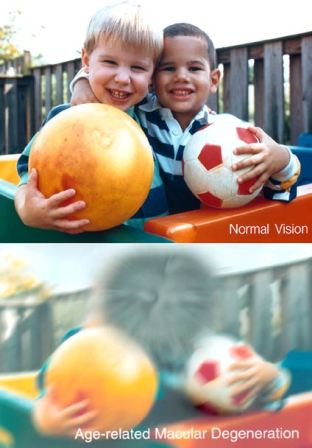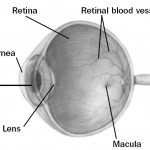Summary:
 Age-related macular degeneration (AMD) is a leading cause of vision loss for people over 60 years of age. Risk factors for AMD include age, genetics, smoking, obesity and high blood pressure. It affects central vision and can be divided into dry and wet types. The progression of dry macular degeneration can be slowed by taking vitamins including vitamins A, E, C, Zinc, copper, omega 3 and lutein/zeaxanthine while wet macular degeneration can be treated with injections of medication into the eye and laser treatment.
Age-related macular degeneration (AMD) is a leading cause of vision loss for people over 60 years of age. Risk factors for AMD include age, genetics, smoking, obesity and high blood pressure. It affects central vision and can be divided into dry and wet types. The progression of dry macular degeneration can be slowed by taking vitamins including vitamins A, E, C, Zinc, copper, omega 3 and lutein/zeaxanthine while wet macular degeneration can be treated with injections of medication into the eye and laser treatment.
A more in-depth explanation of AMD
What is age-related macular degeneration?
Age-related macular degeneration (AMD) is a disease that blurs the sharp, central vision you need for “straight-ahead” activities such as reading, and driving. AMD affects the macula, the part of the eye that allows you to see fine detail. AMD causes no pain. It does not affect your peripheral vision. In some cases, AMD advances so slowly that people notice little change in their vision. In others, the disease progresses faster and may lead to a loss of vision in both eyes. AMD is a leading cause of vision loss in patients 60 years of age and older. As the name describes AMD is a degeneration of the macula. The macula is the name given to the center of the retina, the light-sensitive tissue at the back of the eye. The retina converts light into electrical impulses. The retina then sends these impulses, or nerve signals, to the brain.
What are dry and wet AMD?
Dry AMD occurs when the light-sensitive cells in the macula slowly break down, gradually blurring central vision in the affected eye. As dry AMD gets worse, you may see a blurred spot in the center of your vision. Over time, as less of the macula functions, central vision in the affected eye can be lost gradually. The most common symptom of dry AMD is slightly blurred vision. Dry AMD generally affects both eyes, but vision can be lost in one eye while the other eye seems unaffected. Wet AMD occurs when abnormal blood vessels behind the retina start to grow under the macula. These new blood vessels tend to be very fragile and often leak blood and fluid. The blood and fluid raise the macula from its normal place at the back of the eye. Damage to the macula, and therefore to vision occurs rapidly. With wet AMD, loss of central vision can occur quickly. Wet AMD is considered to be advanced AMD and is more severe than the dry form. An early symptom of wet AMD is that straight lines appear wavy. If you have vision loss from dry or wet AMD in one eye only, you may not notice any changes in your overall vision. With one eye seeing clearly, you still can drive, read, and see fine details. You may notice changes in your vision only if AMD affects both eyes. Dry AMD is much more common than wet. More than 85 percent of all people with AMD have the dry form. However in those with significant vision loss from AMD about two-thirds of patients have the wet form. All people who have the wet form had the dry form first. The dry form can advance and cause vision loss without turning into the wet form. The dry form also can suddenly turn into the wet form, even during early stage AMD. There is no way to tell if or when the dry form will turn into the wet form.
Who is at risk for AMD?
The main risk factors for AMD are age and family history (genetics). Women appear to be at greater risk than men. The only modifiable risk factors are smoking, obesity and high blood pressure so these should be addressed to decrease your risk of vision loss. An Amsler grid should be used to watch for a change in vision that may suggest wet AMD is developing. The pattern of the grid resembles a checkerboard. You will cover one eye and stare at a black dot in the center of the grid at 12 inches distance. While staring at the dot, you may notice that the straight lines in the pattern appear wavy. Sudden changes in the grid appearance should be reported to our office.
What treatment can be considered for AMD?
The National Eye Institute’s Age-Related Eye Disease Study (AREDS) found that taking a specific high-dose formulation of antioxidants and zinc significantly reduces the risk of advanced AMD and its associated vision loss. Slowing AMD’s progression from the intermediate stage to the advanced stage will save the vision of many people. The specific daily amounts of antioxidants and zinc used by the study researchers were: 500 mg of vitamin C, 400 IU vitamin E, 15 mg beta-carotene (often labeled as equivalent to 25,000 IU of vitamin A), 80 mg of zinc as zinc oxide, and 2 mg of copper as cupric oxide. Copper was added to the AREDS formulation containing zinc to prevent copper deficiency anemia, a condition associated with high levels of zinc intake. Smokers need to take a modified version of the supplement without added beta-carotene due to an increased risk of lung cancer. (Vitalux-S is one available formulation) More recent evidence suggests that Omega-3 from fish oils or flax seed oils is also beneficial at reducing the risk of progress in macular degeneration. Caretoids such as Lutein and Zeaxanthine are also felt to have a protective effect and may be beneficial. The AREDS vitamins, Omega-3 and caretoids are not a cure for AMD. They will not restore vision already lost from the disease. However, they may delay the onset of advanced AMD. It may help people who are at high risk for developing advanced AMD to keep their vision. The high levels of vitamins and minerals are difficult to achieve from diet alone. However, previous studies have suggested that people who have diets rich in green leafy vegetables have a lower risk of developing AMD. In addition the levels of antioxidants and zinc are considerably higher than the amounts in any daily multivitamin. A multivitamin contains many important vitamins not found in the AREDS formulation. You may want to take a multivitamin along with the AREDS formulation. For example, people with osteoporosis need to be particularly concerned about taking vitamin D, which is not in the AREDS formulation.
Wet AMD is treated with eye injections Lucentis or Avastin. These are special medicines which cause the abnormal blood vessels under the retina to shrink, but not permanently disappear. This allows the fluid within and under the retina to go away. These injections have been shown to be very effective in preventing further vision loss (90% of eyes) and often allow vision to improve (35% of eyes). Unfortunately, these injections are treatments rather than a cure for AMD and you will require multiple injections on an on-going basis. Your treatments for AMD may also include laser surgery including photodynamic therapy. The disease and loss of vision may progress despite treatment. The type and possibility for treatment depends on characteristics of the wet AMD and will be discussed with you by your doctor. Your lifestyle can play a role in reducing your risk of developing AMD. Eat a healthy diet high in green leafy vegetables and fish. Also don’t smoke, maintain normal blood pressure, maintain a healthy body weight and exercise regularly.
What happens during the eye injections?
Anesthetic drops will be applied to freeze the surface of your eye. A speculum (spring) will be used to hold your eye open. An iodine solution will then be placed on the surface of the eye to sterilize it. You will be asked to look up or behind you to correctly rotate your eye. The medicine will then be injected by your specialist. It is normal to feel a sharp pinch, pressure or popping sensation at the time of the injection. Any discomfort is usually temporary. The remaining iodine solution will then be flushed from your eye. It is normal for the eye to be red after the procedure. New temporary floaters are also common.
